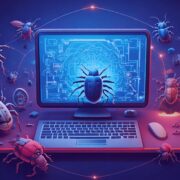At Brandefense, we perceive Advanced Persistent Threats (APTs) as one of the most significant challenges in modern cybersecurity. These threats, marked by their sophistication and long-term objectives, go beyond the capabilities of typical cyber attackers. From Brandefense perspective, APTs are a unique breed of cyber threat, often state-sponsored or linked to organized crime, aiming to establish prolonged access to sensitive networks for data extraction or system disruption.
Operational Strategies Employed by APT Groups
Initial Infiltration:
- Spear-Phishing Campaigns: Highly customized, legitimate emails are sent to specific individuals. These emails might contain malicious attachments or links designed to harvest credentials or install malware.
- Social Engineering: Beyond emails, social engineering can also involve phone calls or other communication forms to trick employees into compromising security.
Exploitation of Vulnerabilities:
- Zero-Day Exploits: These are attacks on vulnerabilities that are not yet known to the software vendor, making them particularly dangerous.
- Software Flaws and Misconfigurations: Exploiting known flaws or misconfigurations in software and hardware to gain unauthorized access.
Quick Tip
You can find IoCs and YARA Rules for APT Groups, Malware, Ransomware etc. in Brandefense Github Repository.
Establishing Foothold:
- Advanced Malware: Using sophisticated, custom-developed malware to maintain presence and evade detection.
- Backdoors and Rootkits: Installing backdoors for continuous access and rootkits to hide their fact from the operating system and antivirus software.
Privilege Escalation and Lateral Movement:
- Gaining Elevated Access: Using various techniques to gain higher-level privileges within the system.
- Network Movement: Moving laterally across the network to access more systems and data, often silently and slowly, to avoid detection.
Critical Characteristics of APT Attacks
Stealth and Persistence:
- Long-term Presence: Maintaining a foothold in a network for months or even years, often undetected.
- Covert Operations: Employing tactics designed to be low-key and unnoticeable, using encrypted channels for communication.
Data Exfiltration:
- Significant Scale Data Theft: Stealing vast amounts of data over a long period.
- Targeted Data Harvesting: Focusing on specific, high-value data that aligns with their objectives.
Distinguishing APTs from Conventional Cyber Threats
Distinguishing Advanced Persistent Threats (APTs) from conventional cyber threats involves understanding the depth and complexity of their strategies, resources, and objectives. Here’s a more comprehensive look into these aspects:
Sophistication
Advanced Tools and Techniques:
- Cutting-edge Technology: APTs often use tools and methods at the forefront of technological advancement. This includes sophisticated malware, advanced persistent code, and complex network intrusion techniques.
- Customized Malware: Development of malware specifically designed for a targeted organization, capable of bypassing standard security measures.
- Evasion Techniques: Employing methods to avoid detection by security software, including polymorphic and metamorphic code.
- Encryption and Obfuscation: Using advanced encryption to protect their communications and obfuscate their malware to avoid detection.
Tailored Attacks:
- Extensive Reconnaissance: Before launching an attack, APTs conduct thorough research on their target, gathering information about internal processes, employee details, and network architecture.
- Spear-Phishing with Precision: Crafting highly personalized phishing attacks based on gathered intelligence.
- Long-term Engagement: Unlike conventional threats seeking immediate payoff, APTs engage in long-term campaigns, adapting and evolving their strategies based on ongoing target surveillance.
Resources
State-Sponsored or Affiliated:
- Nation-State Backing: APTs are often supported or directed by nation-states, providing them with resources and protection beyond the reach of ordinary cybercriminals.
- Access to State Intelligence: They may have access to information from national intelligence services, aiding in the selection and penetration of targets.
Dedicated Teams:
- Skilled Cybersecurity Professionals: APT groups are typically composed of individuals with high levels of expertise in various fields of cybersecurity.
- Multi-disciplinary Expertise: Teams often include experts in network engineering, software development, encryption, and even psychology for social engineering.
Objectives
Strategic Goals:
- Long-term Espionage: Engaging in prolonged espionage operations to gather sensitive information over time.
- Geopolitical Leverage: Undertaking actions that can provide geopolitical advantages to the sponsoring state, such as disrupting the critical infrastructure of adversaries.
- Economic Espionage: Stealing intellectual property and trade secrets for financial gains.
High-Value Targets:
- Government Agencies: Targeting national security apparatus, intelligence agencies, and other government departments.
- Critical Infrastructure: Focusing on energy sectors, telecommunications, transportation networks, and other critical infrastructure for potential disruption or control.
- Large Corporations: Attacking large corporations, especially in industries like technology, finance, and defense, for espionage and competitive advantages.
Challenges in Defending Against APTs
Advanced Nature of APTs:
- Complex Malware and Tactics: APTs often use malware and attack methodologies that are not only complex but also tailored to bypass specific security measures.
- Low and Slow Approach: They typically conduct their operations quietly over long periods, making detection more difficult.
- Polymorphic and Metamorphic Malware: This type of malware changes its code to avoid detection by signature-based security tools.
Proactive Defense Requirements:
- Threat Intelligence: Keeping up-to-date with the latest threat intelligence is crucial. This includes understanding various APT groups’ tactics, techniques, and procedures (TTPs).
- Behavioral Analytics: Implementing systems that can detect unusual patterns of behavior within the network can help identify APT activities.
- Incident Response and Forensics: A robust incident response plan and the ability to perform forensic analysis are essential for identifying and mitigating breaches.
Preventive Measures:
- Regular Security Audits: Conducting thorough and regular audits to find vulnerabilities within the network.
- Employee Training and Awareness: Employees should be trained to recognize potential threats, such as spear-phishing attempts.
- Network Segmentation: Segmenting the network can limit the movement of an APT within a system, reducing the potential damage.
Evolving Landscape of APT Tactics
Ransomware and Diversification:
- Dual Use of Ransomware: Some APTs use ransomware not just for financial gain but as a means to disrupt operations or as a smokescreen for espionage activities.
- Monetization of Attacks: Financially motivated attacks are increasingly being observed in APT campaigns.
Social Engineering and Insider Threats:
- Spear-Phishing: Targeted phishing attacks have become more sophisticated, often involving deep research on the targets.
- Insider Recruitment: APTs are increasingly attempting to recruit insiders within target organizations to aid their attacks.
Supply Chain Attacks:
- Targeting Software Suppliers: Compromising a software supplier can give APTs access to multiple targets that use the software.
- Exploiting Business Relationships: By exploiting trust relationships between businesses, APTs can infiltrate networks that would otherwise be difficult to breach.
Brandefense’s Vision for Future Cybersecurity
Looking ahead, Brandefense is committed to staying at the forefront of cybersecurity innovation to combat APTs. We believe in the power of AI and machine learning to detect and neutralize APT activities and emphasize the importance of fostering a security-aware culture. Collaborating with industry and government entities, we aim to build resilient defenses that can adapt to the ever-changing landscape of cyber threats posed by APT groups.






